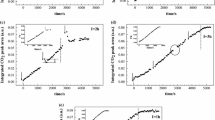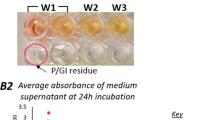Summary
Treatment of fluid samples containing known amounts of ATP with 6.0 N perchloric acid (PCA) results in a total loss of 65–71% when the initial concentrations of ATP ranged between 0.5 to 50 μM. Half of this loss was attributed to desensitization of firefly extract (luciferin-luciferase reaction) while the remaining loss was presumably due to adsorption of ATP to perchlorate precipitate upon neutralization. Similar treatment of solutions with higher initial concentrations (100–1000 μM) resulted in apparent total losses averaging 22%. These losses were due solely to desensitization of firefly extract by neutralized PCA. Both the adsorption and desensitization phenomena must be taken into account when the ATP content is measured from tissue extracts and fluid samples subjected to this procedure.
Similar content being viewed by others
References
Berne, R.M. Cardiac nucleotides in hypoxia: possible role in regulation of coronary blood flow. Am. J. Phys.204, 317–322, (1963).
Berne, R.M., Rubio, R., Dobson, J.G., and Curnish, R.R. Adenosine and adenine nucleotides as possible mediators of cardiac and skeletal muscle blood flow regulation. Circ. Res.,28, Suppl. 1, 115–119, (1971).
Bockman, E.L., Berne, R.M. and Rubio, R. Release of adenosine and lack of release of ATP from contracting skeletal muscle. Pflug. Arch.,335, 229–241, (1975).
Dobson, J.G., Rubio, R. and Berne, R.M. Role of adenine nucleotides, adenosine, and inorganic phosphate in the regulation of skeletal muscle blood flow. Circ. Res.,29, 375–384, (1971).
Forrester, T. An estimate of ATP release into the venous effluent from exercising human forearm muscle. J. Physiol.,224, 611–628, (1972)
Forrester, T. and Lind, A.R. Identification of ATP in human plasma and the concentration in the venous effluent of forearm muscles before, during and after sustained contractions. J. Physiol.,204, 347–364, (1969).
Holton, P. The liberation of adenosine triphosphate on antidromic stimulation of sensory nerves. J. Physiol.,145, 494–504, (1959).
Imai, S., Riley, A.L. and Berne, R.M. Effect of ischemia on adenine nucleotides in cardiac and skeletal muscle. Circ. Res.15, 443–450, (1964).
Katori, M. and Berne, R.M. Release of adenosine from anoxic hearts. Circ. Res.,19, 420–425, (1966).
Kimmich, G.A., Randles, J. and Brand, J.S. Assay of picomole amounts of ATP, ADP and AMP using the luciferase enzyme system. Anal. Bioch.69, 187–206, (1975).
Mentzer, R.M., Rubio, R. and Berne, R.M. Release of adenosine by hypoxic canine lung tissue and its possible role in pulmonary circulation. Am. J. Physiol.,229, 1625–1631, (1975).
Paddle, B.M. and Burnstock, G. Release of ATP from perfused heart during coronary vasodilatation. Blood Vessel11, 110–119, (1974).
Strehler, B.L. and McElroy, W.D. Assay of adenosine triphosphate.Methods in Enzymology, (edit. by Colowick, S.P. and Kaplan, N.O.), Academic Press Chap. 3, 871–873, (1957).
Author information
Authors and Affiliations
Rights and permissions
About this article
Cite this article
Williams, C., Forrester, T. Loss of ATP in micromolar amounts after perchloric acid treatment. Pflugers Arch. 366, 281–283 (1976). https://doi.org/10.1007/BF00585892
Received:
Issue Date:
DOI: https://doi.org/10.1007/BF00585892




